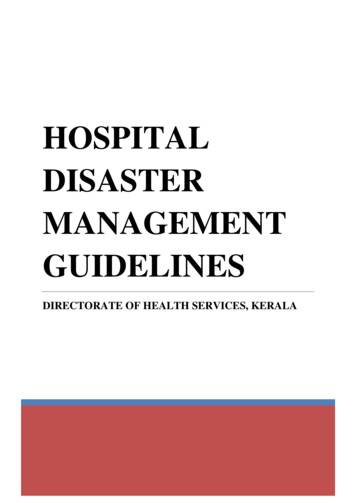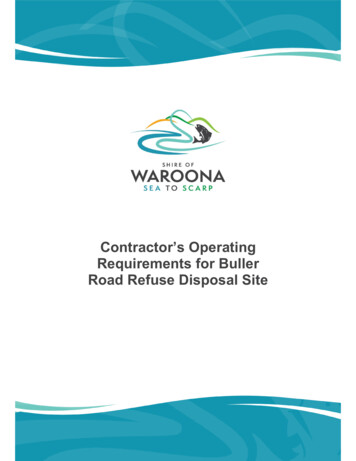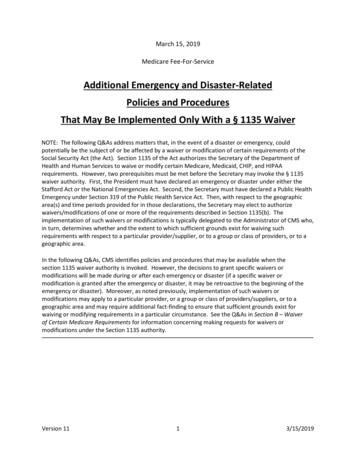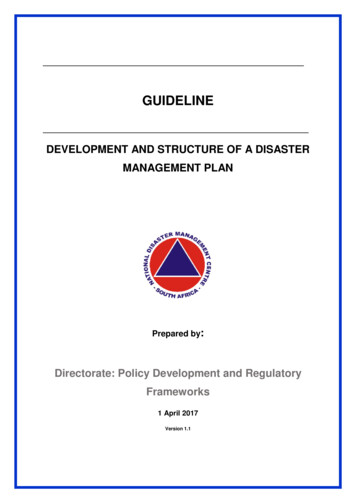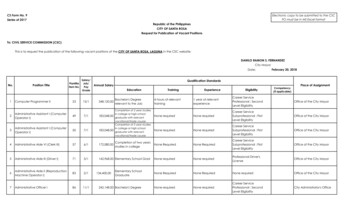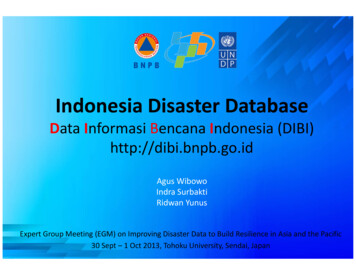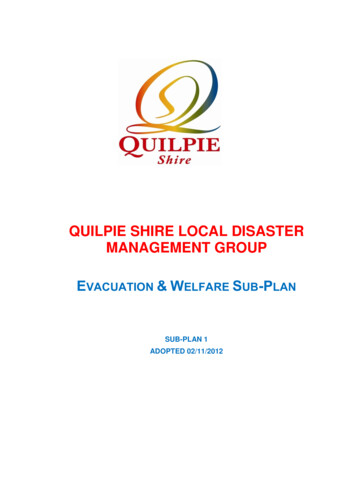
Transcription
QUILPIE SHIRE LOCAL DISASTERMANAGEMENT GROUPEVACUATION & WELFARE SUB-PLANSUB-PLAN 1ADOPTED 02/11/2012
VersionDatePrepared ByComments102/11/2012Dave BurgesOriginal208/12/2015Dave BurgesMinor amendmentsPurposeThe purpose of this evacuation sub-plan is to provide support to local government when planning andimplementing an evacuation of exposed persons within the Quilpie Shire Local Disaster Management Group(LDMG) area of responsibility.The completion of this plan will support the LDMG to: identify local hazards and the population exposed map relevant data document community education awareness programs - before, during and after an event document the decision to evacuate develop and disseminate user-friendly public information and warnings to the community coordinate an organised and coordinated movement of exposed persons to a safer location and theireventual return home.This sub-plan forms part of the Local Disaster Management Plan (LDMP).AuthorityThis plan forms a sub-plan to the Quilpie Shire Local Disaster Management Plan and is developed under theauthority of the Disaster Management Act 2003. This sub-plan will be managed in accordance with theadministrative and governance processes outlined within the Quilpie Shire Local Disaster Management Planincluding approval, document control, distribution and review.Refer to the Evacuation Guidelines in conjunction with other disaster management documents such as, EMAEvacuation Planning Manual (No 11).EndorsementI, Stuart Mackenzie, Chairperson for the Quilpie Shire Disaster Management Group endorse this plan.(signature)(signature)Mayor Quilpie ShireLocal Disaster CoordinatorChairpersonQuilpie Shire LDMGQuilpie Shire LDMGDate:20 / 08 / 2013Evacuation Sub-PlanDate:20 / 08 / 20132
ActivationThis evacuation sub-plan will be activated by the Quilpie Shire LDMG where the movement of exposedpersons to a safer location is required to be coordinated by the LDMG, in close consultation with CharlevilleDDMG.Evacuation CommitteeIf an Evacuation Committee is established by the LDMG, it may assemble upon the activation of this subplan. The committee may also consider business meetings at a minimum every six (6) months to performplanning, review and renew activities associated with the arrangements outlined within this sub-plan.The Evacuation Committee consists of the following members or their nominated delegate (the below listare examples and should be used as prompts only:OrganisationPositionLocal Disaster Management GroupChairLocal Disaster CoordinatorQuilpie Shire CouncilManager Engineering ServicesManager Corporate & Community ServicesQueensland Police ServiceOfficer in Charge of relevant townState Emergency ServiceLocal ControllerQueensland Ambulance ServiceOfficer in ChargeQueensland Fire and Emergency ServicesOfficer in ChargeHuman-social representativesCritical infrastructure providers* The Committee may co-opt additional members or the assistance of individuals or organisations ascircumstances may require. Such personnel and or organisations will be at the discretion of the group.Local hazardsThe following hazards have potential to generate an impact that may require either shelter in place and/orevacuation of exposed members of the various communities within Quilpie Shire: flood severe weather and thunderstorms bush fire urban fire hazmat Incident major traffic accident.Hazard areaThe Quilpie Shire Council covers an area of 67,482 square kilometres and is surrounded by Barcoo andBlackall Shires to the North, Murweh and Paroo Shires to the east and Quilpie Shire to the south. In theShires of Quilpie and Bulloo, the main ranges are the Grey, McGregor and Willies Ranges. The Willies rangeforms the catchment boundary of the Quilpie and Paroo Rivers. The Grey Range separates the CooperEvacuation Sub-Plan3
Creek catchment from the Quilpie River. Within the Cooper Creek catchment the McGregor Range dividesthe catchment, while ranges on the western side of the Cooper Creek at Durham Downs and in the vicinityof Nappamerrie form the boundaries of the limited catchment of Lake Pure.The Bulloo River, a major drainage system, has its source in the Gowan Ranges north of Adavale. TheQuilpie River also has a well-developed flood plain.TOWN OF QUILPIE:Quilpie is situated on the Quilpie River approximately 1000 kms west of Brisbane. Major employer isQuilpie Shire Council, however, a large transport industry operates within the area.TOWN OF EROMANGA:Eromanga is situated 100 kms west of Quilpie. Major employer being the oil, gas and transport, with a smalloil refinery established within the township of Eromanga.TOWN OF ADAVALE:Adavale is situated 100 kms north of Quilpie.RURAL AREAS:Approximately 700 mainly property owners, their families and station workers on large sheep and cattleproperties. Scattered throughout these rural properties are opal mines, very remote and isolated.The annual average rainfall of the Shire is 254-279 mm, with most rain fallingbetween December and March. Temperatures range from 2 degrees to 24 degrees(winter) and 20 degrees to 40 degrees (summer) with mostly dry atmospheric conditions (non-humid).Population exposed:The shire of Quilpie has an approximate population of 1400 people in the townships of ;QUILPIE:Approximately 600EROMANGA:Approximately 50ADAVALE:Approximately 15RURAL AREAS:Approximately 400Vulnerable populationThere are no identified vulnerable populations apart from the usual demographics of a rural communitysuch as: those with health support needs in local hospitals aged population people in residential care people with disabilities transient populations such as tourists.Evacuation zonesThe identified evacuation zones are the:-Evacuation Sub-Plan4
HazardMajor FloodUrban fire (Major)ZoneEromangaAdavaleEromangaEvacuation StrategyFigure 1 outlines a pre-determined evacuation strategy for a range of hazards and associated risks.Evacuation Sub-Plan5
Figure 1HazardQuilpie Shire LDMG Evacuation StrategyExposedAreasPopulationEvacuation MethodSafer LocationEvacuationRouteEstimated EvacuationTimeframeTransport IssuesInc. any specificresourcesrequired toevacuateMajor flood levelsQuilpieNilShelter in placeMajor flood levelsEromanga40Voluntaryevacuation, shelterin placeEromanga Natural HistoryMuseumNone specified1 hourNone identifiedMajor flood levelsAdavale20Voluntaryevacuation, shelterin placeAdavale Sport & RecreationgroundsNone specified1 hourNone identifiedExtreme flood levelsQuilpie50Voluntaryevacuation, shelterin placeQuilpie HallNone specified1 hourNone identifiedBulloo Park (showers, ablutionfacilities and backup mealpreparation and cold storage)Extreme flood levelsEromanga40Voluntaryevacuation, directedevacuation shelterin placeEromanga Natural HistoryMuseumNone specified1 hourNone identifiedExtreme flood levelsAdavale20Voluntaryevacuation, directedevacuation shelterin placeAdavale Sport & RecreationgroundsNone specified1 hourNone identifiedSevereWeather/thunderstorms (e.g.flash flooding, damagingwinds)AllVariesVoluntaryevacuation, shelterin placeDepends on locationNone specifiedVariesRoads may bedamagedorinundatedbyflash floodingBushfireAllVaries (rural)Voluntaryevacuation, shelterin placeDepends on locationNone specified.Dependsondirection of firefrontVariesVisibility may berestrictedLow to severe Fire DangerRating (FDR)
HazardBushfireExposedAreasPopulationSafer LocationEvacuationRouteEstimated EvacuationTimeframeTransport IssuesInc. any specificresourcesrequired toevacuateAllVaries (rural)Voluntaryevacuation, directedevacuation shelterin placeDepends on locationNone specified.Dependsondirection of firefrontVariesVisibility may berestrictedEromanga40Voluntaryevacuation, directedevacuation shelterin placeEromanga Natural ndahRoad1 hourVisibility may dahRoad1 ophic FDRUrban fireEvacuation MethodOutside town limits in a clearzoneEromanga airportHAZMAT IncidentEvacuation Sub-PlanEromanga40Voluntaryevacuation, directedevacuation shelterin placeDepends on scale/type of event.Possibly Outside town limits ina clear zone. Longer termoption Quilpie.7
Community educationCommunity education uses content and communication systems to disseminate community information toraise awareness through a range of media consider print, social media etc.A program of Awareness and Education will need to be implemented to inform the Emergency Authorities asto the location and key personnel of Emergency Centres and for the general public in relation to arrangementsand procedures in the event of an evacuation. Please refer to Evacuation Warning and Advice form APPENDIXA for the template and completed example.Target groupCommunity educationresources/productsQuilpie ShireRefer to ‘EMQ CommunityResidents/Vulnerable education Resources Catalogue’or at risk residents(Catalogue of DM relatedCommunity engagementresources available for Councils.)Delivery optionsThrough QSC to residents as deemed relevantCommunity engagementCommunity engagement is a process that can be used to actively involve the community in disastermanagement planning. Due to the small size of the communities no specific community engagementprocesses are planned.
Decision to EvacuateThe decision to evacuate should be based on a hazard assessment and event intelligence (refer to theEvacuation Guidelines section 7).Please note: where the event has not previously been detailed in the LDMG Evacuation Strategy, developrelevant data for the event, based on the criteria in the strategy.ConsiderationsThe considerations listed below are examples and should only be used as prompts (refer to EvacuationGuidelines section 7.4): Is evacuation the best option? Are there other alternatives? Is it possible to evacuate? Has a risk assessment been undertaken to inform the decision to evacuate? Will it be a staggered evacuation? Have any special arrangements for the vulnerable population been considered?Authority to evacuateA directed evacuation under the Disaster Management Act (the Act) requires the declaration of a disastersituation. A DDC may declare a disaster situation if satisfied that the requirements of section 64 of the Acthave been met. The declaration of a disaster situation requires the approval of the Minister (currently theMinister for Police, Corrective Services and Emergency Services) and must be made in accordance withsection 65 of with the Act. During a disaster situation, the DDC and Declared Disaster Officers are providedwith additional powers under sections 77-78 of the Act. These powers may be required to give effect to adirected evacuation.The process of evacuation requires the approval of an appropriate authority (refer to the EvacuationGuidelines section 7.3).Evacuation TimelinesThe timeframes for the effective implementation of an evacuation, relative to each hazard as specified inFigure 1, have been developed based on the following assumptions and criteria (refer to the EvacuationGuidelines section 7.1): For urban situations there is a minimal distance to the relocation sites Traffic volumes are extremely lowEvacuation Sub-Plan9
WarningsWhen exposed areas and the location of safer areas have been determined, the decision to evacuateexposed members of the community can be made. This information needs to be communicated to thecommunity.Warning dissemination and methodsThe following table documents the agencies responsible for the dissemination of evacuation warnings toexposed populations.QFRS has responsibility for issuing Emergency Alert for fires and hazardous material incidents.Exposed PopulationGeneral PopulationAgency primarily responsible fordissemination of warningWarning MethodMedia releasesLDMG via media contact listsDoor knockingQueensland Police Service with assistancefrom State Emergency ServiceEmergency AlertAuthorising OfficerSDCCLDMG to formally request through DDMGHospitals Nursing Homes,Aged CareDirect contactLDMG via contact listsSchools, DaycareDirect contactLDMG via contact listsShopping CentresDirect contactLDMG via contact listsTouristsVia Tourism Operators, Accommodation ProvidersetcLDMG via contact listsCaravan Parks, CampingGroundsDirect contactLDMG via contact listsPark and camping ground checkQueensland Police Service with assistancefrom State Emergency ServicePeople with a disabilityMethods appropriateunderstandingtoensureaudienceThe development of Evacuation Warnings needs to be prepared by the agency or organisation responsiblefor managing the hazard. This is done in consultation with the following agencies: Quilpie Shire Council Department of Community Safety Department of Employment, Economic Development and Innovation and Queensland Health Queensland Police Services Bureau of Meteorology Local gas companies Local broadcast media outlets Local Disaster Management GroupEvacuation Sub-Plan10
Planning Process must identify the following Mayor and/or Local Disaster Coordinator is responsible for issuing the warnings Mayor in conjunction with relevant lead agency authorizes the message content. Mayor and/or Local Disaster Coordinator provides the alerting and dissemination facilities Welfare Coordinator is responsible for assessing the requirements of special needs groups. (hearingimpaired, non-English speaking, tourists)Message Content Format The issuing authority (the Mayor or his delegate). Date and time of issue. An accurate description of the threat (what has happened or is likely to happen) Details of area affected. Advice on actions to be taken by those receiving the warning. What is being done to control/manage the hazard? Time next warning will be issued.Standard messages to the communityThe standard ‘wording’ content contained in evacuation orders and media release statements should befurther populated with the details relevant to the event and then utilised across all warning methods toensure consistent messages are provided to all sectors of the community.Standard Emergency Alert messages are provided in the Emergency Alert Queensland operationalGuidelines.Message templates are provided in Appendix B and C.Evacuation Sub-Plan11
WithdrawalEvacuation RoutesSelf-evacuation and use of personal transport will be advised by the Quilpie Shire Local DisasterManagement Group in the event of the need for an evacuation.The most suitable routes for an evacuation will be identified and clearly marked by the Quilpie Shire LocalDisaster Management Group to ensure a controlled access and egress process.The community halls in Quilpie, Eromanga and Adavale have been identified as the location of assemblyarea/s for evacuees to move to for registration, information and assistance.The Welfare Coordinator will coordinate arrangements and assistance for special needs groups (aged,medical, disabled, correctional facilities, etc).Quilpie Shire Council, Queensland Police Service and local State Emergency Service personnel will providesecurity of evacuated area/s (roadblocks, traffic control, security patrols).The Mayor and/or Local Disaster Coordinator will provide briefing/s for agencies and evacuees at assemblyareas and emergency accommodation centres to include reason for evacuation, anticipated duration,methods of transport, where to go and how to get there, personal effects, documents and medication to betaken, arrangements for pets/livestock, securing of premises. (turn off power, water, gas, lock up).Traffic Management StrategyNo traffic management strategies are deemed necessary as any evacuations will be small scale and can behandled by local means on local and state roads.TransportEvacuations will be manageable by local transport options.Security StrategyNo specific security strategies have been detailed at this stage.ReportingRegular situation reports on evacuation will be provided to the DDMG.Evacuation Sub-Plan12
ShelterSafer locationsThe following table provides a summary of safer locations with some considerations for selecting locationsmost suitable to the nature of the event, the number of exposed persons and their projected length of stay.This summary table includes assembly points (AP), neighbourhood safer places (NSP) and evacuationcentres (EC).Suggested Considerations Who owns/manages identified facilities and who can access them. Who will establish/open the emergency shelter/s. (who has access/keys) Staffing hours. Transport of evacuees to and from shelter/s. Who will maintain/repair shelter/s?Criteria for Evacuation of Shelters How many people will it hold? (with bedding) Safe access, egress and parking. Location in reasonable safe proximity to incident/disaster site/s. Air-conditioned where possible. Availability for extended periods. Venue known to public. Note: Evaluation should also assess the suitability of venues in relation to categories of evacuees (facilitieswith toilets/showers/kitchens/air-conditioning may be better suited to aged, medically impaired, disabledpersons and young families. Young adults and independently mobile people would be able to transportthemselves to emergency catering areas and hygiene facilities if they are not available in their allocatedfacilities.Initial Recovery ServicesAs indicated in the “Withdrawal” phase, an important component of any evacuation is the establishment of anassembly area for the reception of evacuees. This area should include the following services: Registration & Inquiry. (eg lifeline, Red Cross) Food/refreshments. (Salvation Army or Roma mobile trailer to assist with emergency catering), Meals onWheels, Lions Club, P & C Associations, Apex Club, Hospital Auxiliary, QCWA) Emergency clothing/personal toiletries. (Opportunity Shop, St. Vincent’s de Paul). Finance/Insurance. (xxxx Community Centre/Department of Communities) Shelter. (Allocation of evacuation centre) First Aid. (QAS/Health Clinic personnel) Spiritual Services. (Ministers of religion) Disaster Event Information updated regularly. (Quilpie Shire Council)Evacuation Sub-Plan13
Shelter in placeOutline any specific local information relating to shelter in place (refer to the Evacuation Guidelines section10).Evacuation centresEvacuation centres are to be opened and operational prior to their details being released to the public viaan Evacuation Order.Pets and animalsThe issue of the welfare of pets and animals is low risk. Evacuation numbers will be low and evacuees willremain in the general area. Assistance will be provided on a case by case basis.Evacuation Sub-Plan14
Summary of Safer LocationsLocationType andReferenceNo.NameAssemblyPoint 01Quilpie TownHallAddressEventSuitabilityConsiderationsWild fireBrolga Street Quilpie MajorRespiteAccomm 50 50MinorBulloo ParkBuln Buln StreetQuilpie MajorModerateEvaccentre 02EvacCentre 03FloodModerateEvacCentre 01AssemblyPoint 02CapacityMinorEromangaNatural HistoryMuseumDinosaur Drive via MtMargaret Road,Eromanga Major 50ModerateMinorAssemblyPoint 03Eromanga HallAssemblyPoint 04Adavale HallEvacCentre 04Adavale Sport &Rec groundsEromanga Moderate 50 20 50MinorAdavale ModerateMinorAdavale MajorModerateMinorEvacuation/Welfare Centre Operation and ManagementFor the purpose of efficiency and co-ordination, the Evacuation/Welfare arrangements will be managed within theQuilpie Shirel Local Disaster Coordination Centre (LDCC).Alternative Evacuation and Welfare coordination arrangements may be established at the discretion of the LDC,Welfare Committee Chairperson and in consultation with the Local Emergency Coordination Committees (LECC) ofthose affected communities.The Chairperson of the Welfare Committee will be responsible for the staffing of Welfare Centres in consultation withthe Local Disaster Coordinator and the LECC.Evacuation Sub-Plan15
ReturnThe decision for the return of evacuees and the development of a return strategy will be undertaken by theLDMG in close consultation with following stakeholders: District Disaster Coordinator and relevant District Functional Committees QFRS representative Electricity provider Communications provider Local Government operational business unit (as relevant, may include Environmental Health, Waterand Sewerage, Roads and Drainage and Building Services). Department of transport and Main Roads (where relevant for State-run Road’s and infrastructureThe return of evacuees will be dependent on a number of factors. It will be necessary to assess the areaagainst the following criteria to determine if return is possible and identify any special conditions, whichmay need to be imposed. Documentation of arrangements to deal with the following should be included.Authorisation for return to affected areas will be determined by the Quilpie Shire Council and the QuilpieShire Local Disaster Management Group representatives.Considerations for return Absence of Hazard. Availability, condition and safety of:-Accommodation.-Utilities. (eg. power, water, sewerage and waste disposal)-Public/environmental health. Availability of adequate food supplies for returnees. Safe transport/access routes. Distance to affected area. Sufficient resources to return evacuees. (private vehicles/buses/etc) Public information on:-Prognosis on areas that are and will be accessible in order of priority. This information should alsoinclude any special conditions imposed in relation to the 3 return processes.1. Temporary: Access to area to restore/clean up of property. (daylight hours only)2. Partial: Restricted access to those residents whose homes/buildings have been inspected anddeclared safe and infrastructure and essential services (power/water/sewerage) are restored.3. Complete: Total area is declared safe and unrestricted access authorized. Transport schedules. Precautions/restrictions (health warnings, etc). Health and medical services. Food supply and feeding arrangements.
Financial and welfare/recovery arrangements and services.Return StrategyOnce it is determined areas are safe for return, a return strategy is to be developed to outline thearrangements necessary to plan and implement an organised return and how that process will becoordinated and managed. The return strategy should address, but is not limited to the following: specific areas deemed safe for return security of damaged, unsafe structures or infrastructure detailed return advice to evacuees traffic management plan transportation requirements.Evacuation Sub-Plan17
Annexure A – Operational ChecklistEvacuation: Operational ChecklistEvent:ActionResponsible Agency / OfficerSpecific InformationStatusDecision to EvacuateConsider the specific circumstances of the event and review/refinethe pre-determined Evacuation Strategy in light of:AssignedCompleted- advice from relevant authorities on severity, arrival and impactarea;- the applicability of pre-determined vulnerable zones andmodification of existing or development of additional maps asrequired;- the nature of the exposed population;- the capacity of proposed evacuation routes to support rapid egressgiven the specific event related conditions;- the suitability of safer locations;- the requirements of special needs populations and associatedactions;- specific transport issues- the availability of appropriate resources to effectively manage allaspects of the evacuation.Consider all aspects with particular emphasis on the time required tocomplete the evacuation and the lead time available. Conduct alocal risk assessment.AssignedCompletedIs evacuation the most suitable option?Decide on the type of evacuation being contemplatedAssignedCompletedDefine the timeframe for conduct of evacuation if pre-impactAssigned
ActionResponsible Agency / OfficerSpecific InformationStatusCompletedDetermine the amount of external assistance that will be required toeffect evacuation.AssignedAdvise DDC that evacuation decision has been made and make arequest for assistance, if requiredAssignedRecommend to DDC that directed evacuation is esEnsure adequate copies of evacuation zone maps for operationalteamsAssignedCheck current and predicted status of evacuation routesAssignedCompletedCompletedPopulate Evacuation Order templates with relevant informationincluding affected zones and sequence of evacuation. Hold pendingapproval for releaseAssignedConfirm and ready warning mechanismsAssignedCompletedCompletedWhere transportation will be required, review Transport StrategyAssignedCompletedRefine traffic management strategy and stage traffic control devicesat required locationsAssignedConfirm evacuation centres, arrange opening, manning of centresand test of communication system back to LDCCAssignedActivate Evacuation Centre Management / Public Health ion Sub-Plan19
ActionResponsible Agency / OfficerSpecific InformationWhere warning mechanisms will include door knocking, mobilepublic address systems etc refine grid/locality system to ensurecoverageStatusAssignedCompletedWarningUpon authorisation for release, issue voluntary evacuation advice toexposed populationAssignedProvide notice to exposed population facilities to evacuateAssignedCompletedCompletedReceive authorisation for directed evacuation from DDC, if requiredAssignedCompletedIssue directed evacuation order to the population exposedAssignedCompletedProvide evacuation teams with written order to be provided tomembers of publicAssignedCompletedWithdrawalActivate traffic management strategyAssignedCompletedActivate door to door evacuation teamsAssignedCompletedActivate transport strategyAssignedCompletedEnsure evacuation messages continue to be conveyed to public.AssignedCompletedConsider the needs of the identified vulnerable populationConsider tailoring to vulnerable populationEvacuation Sub-Plan20
ActionResponsible Agency / OfficerSpecific InformationProvide regular situation reports on evacuation to DDMGStatusAssignedCompletedEnsure regular reporting from field teams of completed tasksAssignedCompletedImplementation of security strategy for evacuated areasAssignedCompletedShelterEnsure evacuation centre management being coordinated throughEvacuation Centre Management Sub-planAssignedRequest and maintain a record of evacuees at evacuation centresuse programs such as NRISAssignedIf evacuees are being registered upon leaving exposed areas, ensurerecord is being maintained including details of rnDetermine areas that are safe for return with consideration of thefollowing issues:-content of impact assessment-health and safety issues-functioning of utilities; power, water, sewerage andcommunications-status of repair; clearing and re-opening of roadsAssignedCompletedReview and modify the Return Strategy, addressing:Assigned- specific areas deemed safe for returnCompleted- security of damaged, unsafe structures or infrastructure- detailed return advice to evacuees- traffic management planEvacuation Sub-Plan21
ActionResponsible Agency / OfficerSpecific InformationStatus- transportation requirementsAdvise DDMG of Return StrategyAssignedCompletedConsider the needs of the identified vulnerable populationIssue media release outlining return strategy for evacuees. Distributereturn advice to Evacuation Centres and notify special facilities.Consider tailoring advice to vulnerable populationsAssignedRelease appropriate information to returning evacuees onreactivation of utilities, damage repairs, clean up and debris removal,types of and contact process of personal – human social recoverysupport servicesAssignedImplement traffic management planAssignedCompletedCompletedCompletedMaintain security controls for those areas that cannot be safelyreoccupiedAssignedEnsure the coordination of temporary housing for evacuees unableto return to their residencesAssignedClose evacuation centresAssignedCompletedCompletedCompletedComplete final situation report on evacuation and stand downEvacuation Committee, if this committee has been establishedEvacuation Sub-PlanAssignedCompleted22
Annexure B – Voluntary Evacuation AdviceTOP PRIORITY FOR IMMEDIATE AND FREQUENT BROADCASTTransmitters serving the area/s of [insert locations] are requested to use the STANDARDEMERGENCY WARNING SIGNAL before broadcasting this message.VOLUNTARY EVACUATION ADVICEFor [insert hazard]Issued: [Time, Day, and Date]As a result of the [insert impact e.g. flood level] associated with [insert event] advised by [insert authority e.g.Bureau of Meteorology] for [location] at [date/time]. [Insert name] Local Disaster Management Group is advisingresidents within the [nominated areas/ evacuation zones] to evacuate within the next [number] hours.Do not delay your evacuation. Roads will be congested or closed. You could become isolated and need rescue.Remaining in those areas nominated for evacuation is dangerous and may place your life at risk.You are encouraged to relocate to family and/or friends outside the area nominated for evacuation.As you evacuate you should: take your emergency kit, evacuation kit and emergency plan with you (such as cash/cards, bedding, medications& prescriptions and specifics including baby formula, glasses)ensure neighbours have received and understand the evacuation orderturn off the electricity and gas and lock your homedo not walk or drive through floodwatercontinue listening to your local radio station for further information and instructions.For assistance or further information telephone the Local Disaster Coordination Centre on telephone number orview the website at: www. insert address The name Local Disaster Management Group would appreciate this order being broadcast regularly.Authorised By: [insert name & operational position title ]Message End
Annexure C – Evacuation OrderTOP PRIORITY FOR IMMEDIATE AND FREQUENT BROADCASTTransmitters serving the area/s of [insert locations] are requested to use the STANDARDE
SDCC LDMG to formally request through DDMG Hospitals Nursing Homes, Aged Care Direct contact LDMG via contact lists Schools, Daycare Direct contact LDMG via contact lists Shopping Centres Direct contact LDMG via contact lists Tourists Via Tourism Operators, Accommodation Providers etc LDMG via contact lists Caravan Parks, Camping Grounds

